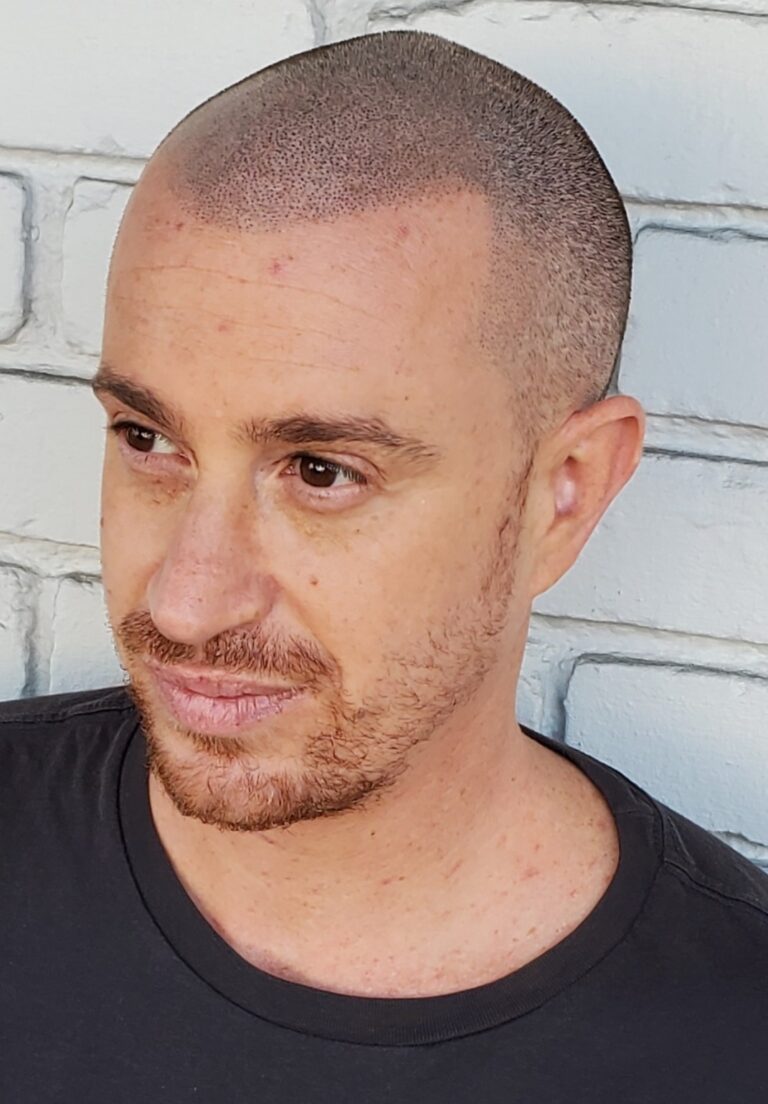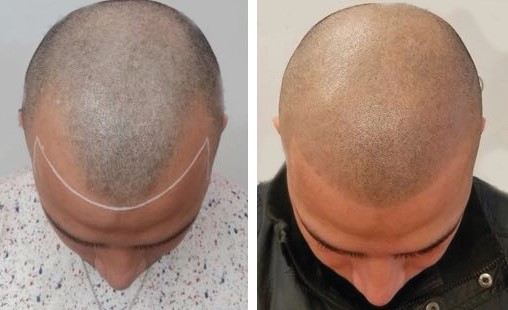What is scalp micropigmentation?
Scalp micropigmentation, sometimes referred to as a hair tattoo, is a cosmetic treatment designed to help people with thinning hair or hair loss. The provider carefully uses thin, small needles to deposit tiny dots of cosmetic-grade, permanent pigment on the scalp to give the appearance of thicker hair.
Scalp micropigmentation, when performed by a skilled technician, can be used to hide thinning areas or bald patches on the scalp, birthmarks and scars. It can also be used to create the illusion of a shaved head or “buzz cut” on bald individuals. The best part is this treatment doesn’t require surgery or anesthesia, and it is completely noninvasive.
Who is scalp micropigmentation for?
A treatment known as scalp micropigmentation is a type of permanent makeup which can be used to give people with thinning hair or who are balding the appearance of having thicker hair:
- Alopecia areata is an autoimmune issue that leads to hair falling out from the scalp. This can be a troubling and upsetting condition for many people who experience it.
- Going through chemotherapy can be challenging in many ways, but one of the most difficult, and often overlooked, aspects is the hair loss that can come with it. It can leave many feeling like they have lost a part of themselves and cause a deep sense of sadness and despair. The effects on self-image and self-esteem can be profound, too.
- When a woman starts to lose her hair, it can be a difficult time in her life – it’s not easy to accept or understand.
- One of the conditions that can be at the root of hair loss is polycystic ovary syndrome (PCOS). This condition is caused by an imbalance of hormones that can leave you with a lot less hair than you’d like.
- Male pattern baldness, which can involve a receding hairline at the temples and baldness at the crown of the head, is becoming increasingly common.
- Thinning hair or scalp that is visible through the hair.
- Injuries, marks or scars on the scalp that could be caused by a variety of factors.
Does scalp micropigmentation grow hair?
While scalp micropigmentation won’t actually help regrow hair or change your natural hair growth and isn’t a form of treatment for hair loss, it also won’t cause hair loss or damage existing hair follicles. Instead, this procedure provides the illusion of fuller, thicker hair that looks like it’s grown naturally.
Scalp Micropigmentation Before and After : PROCEDURE DETAILS
What happens before scalp micropigmentation?
Before scalp micropigmentation:
- Before you arrive for your appointment, make sure that you have washed your hair and scalp properly.
- When you get there, your practitioner jots down the sections of the scalp that will be attended to.
- If you’re bald, your healthcare provider and you can collaborate to devise a hairline that best suits your facial structure, age and head shape.
- When selecting the correct pigments to match the desired hair color, you and your provider should take your time to make sure it’s the perfect shade.
- To ensure that you are as comfortable as possible during the procedure, your practitioner will apply a topical numbing agent to the scalp. The micropigmentation needles used are also extremely thin and small, ensuring that any potential pain is much lower than that of getting a traditional tattoo.
What happens during scalp micropigmentation?
In order to create a natural, hairlike effect, your provider will use a medical-grade needle to deposit small pigment dots on the spots you desire. The dots can vary in size, angle and depth to create the most realistic look possible.
Depending on the size of the treatment area, your treatment may take anywhere from 5 hours. Most people need at least three individual treatments with some weeks of space in-between them. Every successive treatment will add additional pigment to make it look like a fully-haired scalp.
What happens after scalp micropigmentation?
As there is no surgery or anesthesia involved, you can resume your daily activities without delay. Very few side effects accompany scalp micropigmentation – the only significant one being a possible redness of the scalp which lasts a few hours. If necessary, you can choose to cover it up with a hat or a scarf.
RISKS / BENEFITS
What are the advantages of scalp micropigmentation?
The advantages of scalp micropigmentation in comparison to hair transplantation surgery are plentiful, such as its fast healing time and cost efficiency:
- Less invasive (no surgery or incisions).
- Less pain.
- Lower cost.
- No downtime.
What are the risks or complications of this procedure?
Taking the necessary precautions is essential when opting for scalp micropigmentation and seeking out a licensed, experienced practitioner is of the utmost importance to avoid the potential risks. Possible downsides include infection, scarring and discoloration, all of which should be discussed beforehand with your practitioner:
- The use of certain cosmetic pigments can cause a severe allergic reaction. Take care to be aware of any potential reactions.
- The risk of contamination due to unsterilized needles.
- Unnatural or undesirable physical features and look after treatment, which is not very favorable.
To avoid these risks:
- To ensure that you get the desired results, it is essential to go with a scalp micropigmentation technician that is licensed and has the expertise to deliver the best results.
- I was hoping you could show me some before and after photos of your scalp micropigmentation efforts. It’d be great to get a glimpse of what the results look like.
- If you have any allergies, it’s essential to make sure to let your technician know beforehand, as this could have an impact on the procedure.
Is there anyone who shouldn’t get scalp micropigmentation?
Individuals with a history of keloids (scars that increase in size beyond their initial size) should not get scalp micropigmentation as the treatment may cause keloids to form.
RECOVERY AND OUTLOOK
What is the recovery time after scalp micropigmentation?
After the treatment, you may need to avoid certain activities for several days, including:
- Keeping your scalp dry is important. To do this, use a shower cap during showers, or take baths instead. Do not attempt to cleanse your hair or scalp until you have the go-ahead from your healthcare provider.
- Heavy exercise should be avoided for at least 48 hours after your procedure. You may resume light exercise after 24 hours.
- Hot showers and steam rooms, the steam gathering on your scalp like a fog and clinging to every strand of hair. You can almost feel the moisture embracing you as it slowly and gradually caresses your scalp.
- Allowing your scalp to be in direct contact with the sun’s ultraviolet rays.
- Experiencing an increase in body temperature or excessive sweating.
How long does scalp micropigmentation last?
With scalp micropigmentation, results can typically be expected to last for four years or more. To achieve this, permanent cosmetic pigments are used, rather than tattoo inks, as these are more resistant to fading and color changes.
What is scalp micropigmentation?
Scalp micropigmentation, sometimes referred to as a hair tattoo, is a cosmetic treatment designed to help people with thinning hair or hair loss. The provider carefully uses thin, small needles to deposit tiny dots of cosmetic-grade, permanent pigment on the scalp to give the appearance of thicker hair.
Scalp micropigmentation, when performed by a skilled technician, can be used to hide thinning areas or bald patches on the scalp, birthmarks and scars. It can also be used to create the illusion of a shaved head or “buzz cut” on bald individuals. The best part is this treatment doesn’t require surgery or anesthesia, and it is completely noninvasive.
WHEN TO CALL THE DOCTOR
When should I see my healthcare provider?
If after scalp micropigmentation you begin to experience any signs of infection, it is important to call your healthcare provider right away:
- Fever.
- Pus or drainage.
- Severe pain.
- Severe redness.
- Swelling.
FREQUENTLY ASKED QUESTIONS
What questions should I ask my provider before scalp micropigmentation?
When you’ve decided on a licensed and experienced micropigmentation specialist, make sure to ask them:
- Is scalp micropigmentation a good option for me?
- Is it realistic to anticipate that my expectations will be met?
- What steps can you take to make sure that I am as comfortable as possible throughout the procedure?
- What should I do following the procedure to give my scalp a full, fluffy appearance?
Does insurance cover scalp micropigmentation?
Scalp micropigmentation and permanent makeup are not medical requirements, they are elective (optional) procedures. Before you decide to go through with either procedure, it is important to ask your provider about the cost of the procedure as well as how many treatments you may need to get the desired result.
Is scalp micropigmentation worth it?
Those who get scalp micropigmentation performed by a skilled provider often find that they’re satisfied with the results. With the pigments lasting several years, it’s a low-maintenance and long-lasting treatment option.
A note from Cleveland Clinic
Don’t let hair loss or thinning get in the way of your self-confidence. There are a number of conditions that can cause it, including alopecia, male pattern baldness or hormonal conditions. You might also have a scar or birthmark you want to conceal. Fortunately, scalp micropigmentation is a great noninvasive alternative to make your hair look thicker.


